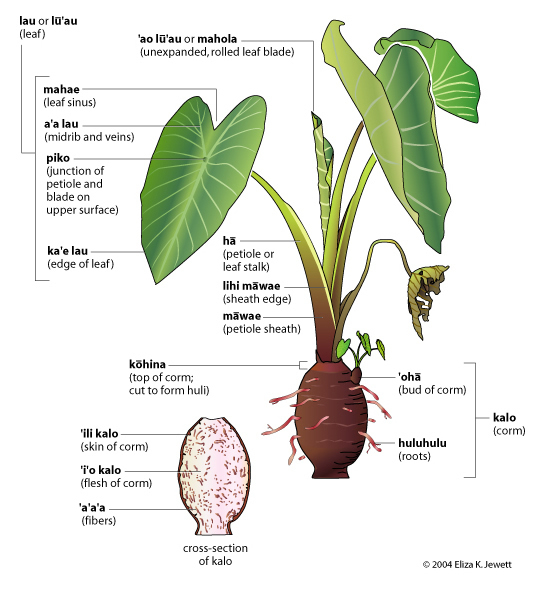
‘a‘a‘a: Vascular bundles, or fibers in the taro corm (kalo).
a‘a lau: Midrib and veins of the taro leaf.
‘ala: Fragrant, sweet-smelling, perfumed.
‘ao lū‘au: Unexpanded leaf blade of taro.
‘api‘i: ruffled, curly; kalo variety with crinkles under the leaf.
‘apo wale: To grasp needlessly.
‘apu: Coconut shell cup; to drink; a general name for medical potions made from taro; a taro variety.
blade: Broad part of a leaf.
corm: Bulb-like underground modified stem with rings of leaf scars on the surface.
‘eka‘eka: Dirty; red color of soil.
‘ele‘ele: Dark-colored; black.
‘elepaio: A Hawaiian species of flycatcher (bird); a variety of taro with mottled leaves.
hāloa: long petiole; name for Lauloa taro; name of a son of Wākea, the mythical ancestor of all Hawaiians.
hinu: Oily, greasy, smooth & polished.
huli: Taro top or shoot; planting material consisting of a large central bud cut from the apex of the corm; 30-60 mm of corm attached to 15-30 cm of the basal portion of the petiole.
huluhulu: Adventitious roots arising from the corm; lit. hair, hairy.
‘ili kalo : Skin, rind, outer surface of the taro corm.
‘i‘o kalo : Flesh of the taro corm.
ka‘e lau: Margin or edge of the taro leaf.
kahuna: Priest.
kāī: The name of a group of taro varieties, possibly tolerant of saline conditions? (kai - salt water)
kalalau: Wanderer; name of a valley on Kaua‘i.
kalo: Taro (Colocasia esculenta), whole taro plant; parent corm (kalo-makua).
kalo malo‘o: Dry or upland taro.
kalo wai: Wetland taro.
kea: Light-colored, white.
ke‘oke‘o: White or whitish, very light colored.
kōhina: Part of the taro where the corm is cut away from the top.
kūlolo: Hawaiian pudding prepared from baked or steamed grated taro and coconut milk or cream.
kūmū: A red-colored goatfish (Parupeneus porphyreus); a variety of taro.
lauloa: Long leaf.
laulau: Wrapping, packages of taro leaves containingpork, beef, salted fish or taro tops, baked in the ground oven (imu), steamed or broiled.
leaf: An expanded, photosynthetic (green) organ of a plant (lau, lū‘au).
lehua: A group of taro varieties making red poi.
le‘o: Lofty, tall, high; influence arising from station; a taro variety.
lihi māwae: Edge, rim, margin (lihi) of the petiole groove (māwae).
liko: Leaf bud; newly opened leaf; the first leaf of a taro plant.
loa: Long, tall.
lo‘i: An irrigated terrace for growing taro.
lola: Drooping leaf.
lū‘au: Young taro tops; young, delicate inner leaves baked with cocnut cream and chicken or octopus; Hawaiian feast.
maea: Strong or bad smelling.
mahae: To tear or split; leaf sinus or indentation.
mahola: To spread out; unexpanded leaf blade.
mākoko: Reddish.
makua: Parent; mature; main stalk of a taro plant.
mana: To branch; group of taro varieties characterised by branching of parent corm at apex.
mane‘o: Itch, itchy; smarting of the throat after eating raw taro or greens.
manini: A common striped reef surgeonfish (Acanthurus triostegus), commonly called 'convict tang'; a variety of taro with striped petioles.
maoli: Native; indigenous; genuine.
maturity: Time at which corm reaches full size and ready for harvest; can be indicated by yellow color of senescent leaves, shortness of petioles, and decrease in size of leaves. ref
māwae: Crack, crevice; petiole groove.
moana: Broad, wide.
moano: Pale red; the color of the moano fish, a goatfish (Parupeneus multifasciatus).
moi: A threadfish (Polydactylus sexfilis); a taro variety.
nāwao: A domesticated taro that has gone wild in the forest (wao).
‘oene: Small sized taro; last taro taken from a crop; a taro variety.
‘ohā: Corms (cormlets), suckers or shoots produced from the parent corm.
‘ohe: Hawaiian bamboo.
‘oko‘a: Different, urelated, another.
‘ōma‘o: Green.
‘o‘opukai: A taro variety having petioles with a color similar to the salt water (kai) ‘o‘opu (Species name?).
‘ōpelu: A fish (mackeral).
‘owali: Weak, sickly.
‘owene: Small sized taro; last taro taken from a crop.
pa‘i ‘ai: Hard pounded but undiluted taro.
pākē: China, Chinese.
pala: Soft, ripe, mellow, soft, rotten, to yellow.
papa: Native born; a stratum, layer, or foundation..
pele: Lava flow, volcano, eruption; the volcano goddess, Pele.
petiole: Leaf stalk or stem (hā).
piko: Navel; upper surface of a leaf blade at the point of junction with the petiole; group of taro varieties characterised by the blade cut to the sinus.
poi: Pasty mass made by pounding or grinding cooked taro corms, with sufficient water added to obtain proper consistency.
pololū: Long spear; valley on Hawai‘i.
poni: Royal; purple.
pua: Flower or blossum.
pu‘u: Secondary cormlets, too small to cook and not yet producing leaves (lit. a protuberance).
saggitate: Arrow-head shaped.
sinus: Cleft, depression or recess between the two lobes of the taro leaf.
uaua: Tough, elastic, viscid, glutinous, leathery, not easily broken.
‘ula‘ula: Red, rosy, scarlet (‘ula).
uliuli: Dark or dusky color (uli).
‘ulu: Breadfruit (Artocarpus altilis).
wai: Water, liquid.
